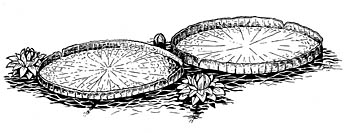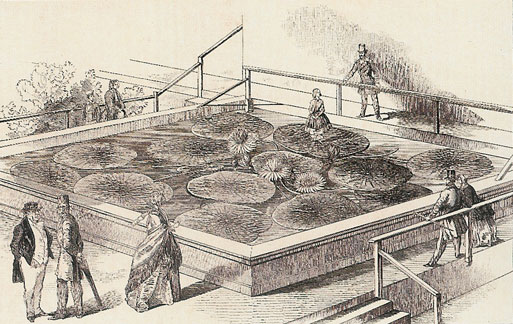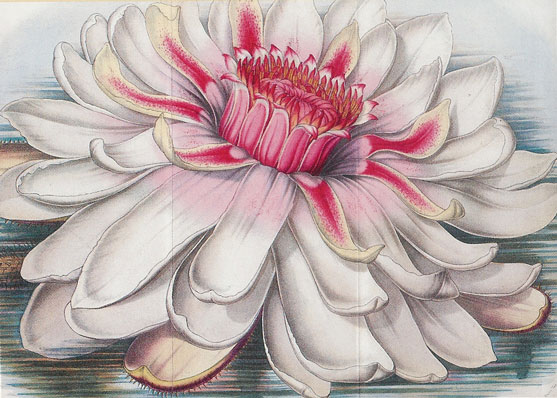Victoria: The Reigning Queen of Waterlilies
by Jennifer Davit
Photos by Claudia Cebrian
Fairchild is now displaying the Amazon waterlily, Victoria amazonica in a new pool that provides the ideal environment for the growth of the queen of waterlilies.
Sibley Victoria amazonica Pool
Clearly, the unique botanical characteristics, life cycle, cultivation history, and tropical origins make Victoria an ideal specimen for display at Fairchild. Cultivation at Fairchild does not require a glasshouse due to South Florida's mild climate. FTBG staff has grown Victoria in the past, but the new Sibley Victoria amazonica Pool provides an ideal growing environment that was previously lacking. The Sibley Pool was designed and constructed by local landscape designer Bernie Ortega. Groundbreaking began in early 2004 and the plants were installed in late March. Fairchild received plants from Kit and Ben Knotts, who reside in Cocoa Beach, Florida, and share a passion for Victoria. The Knotts grow plants from seed for display in their ponds and for distribution to botanical institutions. They provided Fairchild with a Victoria amazonica, V. cruziana, V. 'Longwood Hybrid', and V. 'Adventure'. V. amazonica is native to Brazil, Colombia, Guyana, Venezuela and Peru, while V. cruziana is native to Argentina, Brazil, Paraguay, and Uruguay. Patrick Nutt of Longwood Gardens made the first successful cross of these species in 1960, appropriately naming it V. 'Longwood Hybrid'. Each of the species and hybrids varies in pad color, pad size, pad rim color, and height of the upturned rim of each pad. These hybrids are grown at Fairchild because they can tolerate cooler temperatures, extending the growing season for these plants which Fairchild will grow as annuals.
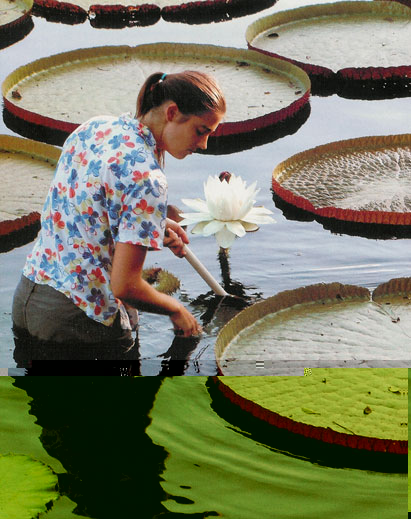
Fairchild's Conservatory Manager, Jennifer Davit measures overall plant surface area and notes the largest growth increase in the V. 'Longwood hybrid' from 5.9 square feet to 35 square feet over a two week period.
The giant water lily, Victoria, is amongst the most spectacular of tropical plants. Tadeas Haenke f1~st discovered Victoria in 1801 in Bolivia, but before he could report on his finding, Sir Richard Schomburgk found Victoria in 1837 in British Guiana. He presented his findings to the London Botanical Society, generating both wonder and excitement. So much so that the plant was named Victoria in honor of the British Queen. In 1849, the Royal Botanic Gardens, Kew received viable seeds from South America. Joseph Paxton, head of the Duke of Devonshire's gardens at Chatsworth, received a seedling from Kew and was the first horticulturist to bloom Victoria amazonica in cultivation. Paxton, inspired by the extraordinary leaf structure of the waterlily, designed the structure of the Crystal Palace in London. The design of these structures has influenced subsequent greenhouse and conservatory constructions.
Pink and white
The Victoria's nocturnal flowers are impressive, as is their bizarre pollination biology. The flowers open a pure white on their first night and emit a strong pineapple-like scent. This attracts the scarab beetle pollinator (Cylocephata castaneal) to the flower, which is functionally female that evening and receptive to pollen brought by the beetle. As daybreak approaches, the flower begins to close, trapping the beetle inside. During the day the flower becomes functionally male, indicated by the maturation of the anthers and the release of pollen. The beetle becomes coated with the pollen, but cannot fertilize the flower because it is now functionally male. The flower opens the second evening, having changed color from white to pink. The beetle is released and seeks out another white, fragrant, receptive flower, where it will deposit pollen to allow seed set.
A notch above the rest
Victoria exhibits some extraordinary structural characteristics. A notch in the middle of the leaf rim allows rainwater to drain from the surface of each pad. Spectacular sharp spines cover the underside of the leaves, the stems, and the flower buds, protecting the leaves from animals and fish. A web-like structure of hollow ribs supports the underside of the leaves; these ribs are filled with air and provide for exceptional buoyancy. In an experiment using sandbags, Victoria were found to support up to 300 pounds on a single pad. Young plants can grow at an amazing rate, exhibiting increases in individual pad diameter of over eight inches in one day.
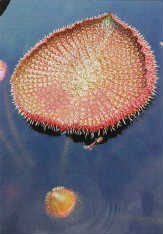
Emerging Victoria amazonica leaf with visible spines and new flower bud below.
Year Two - 2006
The Giant Amazon Waterlilies are flourishing at Fairchild. Historically, Victoria amazonica — found growing in pools off the Amazon River in hot, humid conditions — have fallen prey to Miami's winters. This is the first time these aquatic plants have lived to see a second year at Fairchild.
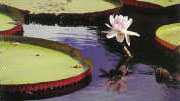
V. amazonica pads span up to three feet.
People love Victoria for their huge leaves. At the Benjamin Rush Sibley Victoria Pool, the pads now span three feet in diameter and are continuing to grow. Horticulturists tracking the amazing growth rate of the Victoria have measured a daily increase in diameter of up to eight inches. These Amazon lilies are also famous for the dangerous spines that cover the stems and underside of each leaf, protecting the plants from predators.
Currently the Victoria 'Adventure' pads cover 40 square feet of the pool. In addition to breathtaking leaves, this plant also produces stunning flowers with an intoxicating scent. The Victoria 'Longwood Hybrid' produced its first flower of the season on the evening of May 31 and now flower weekly. To spot these flowers, come early — they close around 10am.
